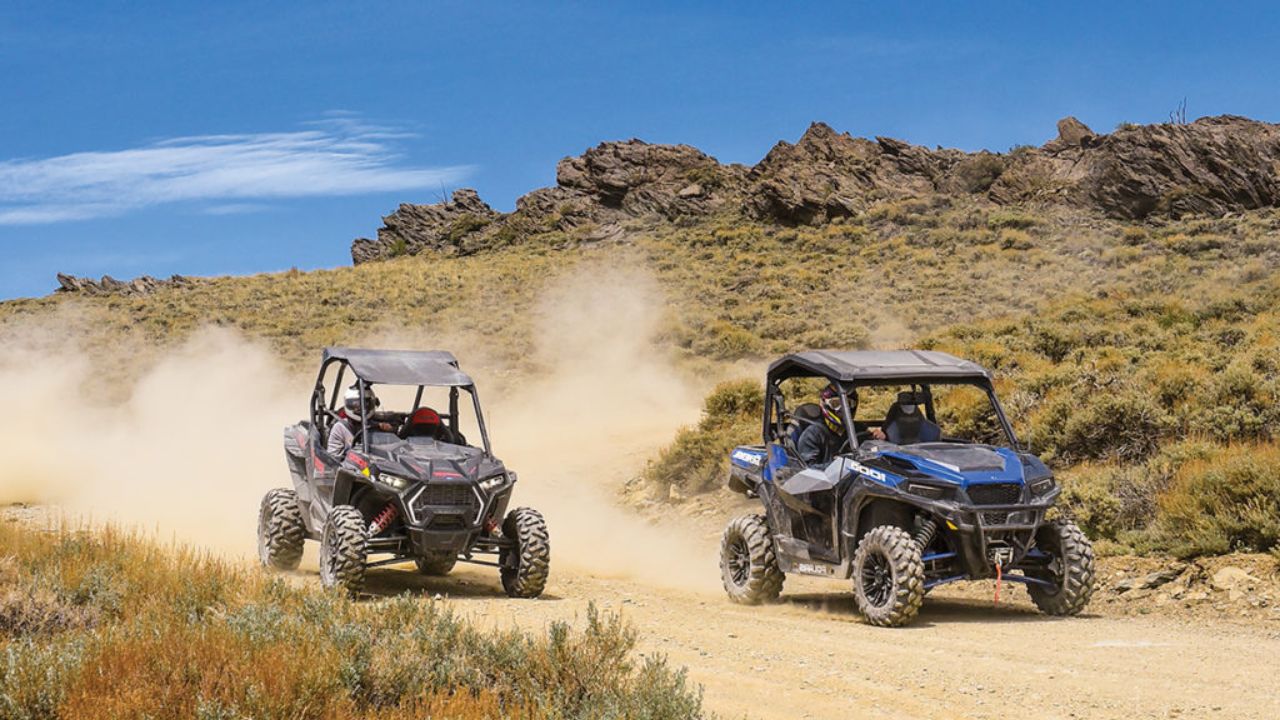In recent years, side-by-side vehicles, also known as utility terrain vehicles (UTVs) or recreational off-highway vehicles (ROVs), have gained significant traction among outdoor enthusiasts and professionals alike. These four-wheel-drive vehicles feature a side-by-side seating configuration, resembling miniature off-road buggies. Their growing popularity stems from their versatility, off-road capabilities, and recreational appeal, attracting a diverse range of users.
However, before hitting public roads, it’s crucial to navigate the legal landscape carefully. Regulations regarding side-by-sides vary, necessitating compliance with local laws and safety standards to ensure a smooth and lawful riding experience. One common query among enthusiasts is, “Can a side-by-side be street-legal?”
Can a Side-by-Side Be Street Legal?
Can a side-by-side be street-legal? The answer is a complex “It depends.” There is no universal rule, as regulations are determined at the state and sometimes even local level. Some states allow side-by-sides to be modified for street use, while others have heavy restrictions or outright ban them on public roads. If your state permits it, expect to add features like mirrors, turn signals, DOT-approved tires, and a windshield. You’ll likely need to register the vehicle and may require a special driver’s license endorsement. Since laws continuously evolve, always research the most up-to-date regulations in your specific location.
Differences Between Side-By-Sides and Other Off-Road Vehicles
- Seating Configuration: Side-by-sides feature a side-by-side seating arrangement similar to that of a car, providing a more comfortable and secure ride than traditional ATVs’s straddle seating.
- Capacity: Side-by-sides typically offer to seat two or more passengers, making them ideal for family outings or group adventures, whereas ATVs usually accommodate only one rider.
- Utility Features: Side-by-sides often come equipped with cargo beds, towing capabilities, and other utility features, making them suitable for both recreational and work-related tasks, whereas dirt bikes and motorcycles primarily focus on recreational use.
- Stability: Side-by-sides typically have a lower center of gravity compared to ATVs, providing greater stability, especially on uneven terrain, enhancing safety during off-road adventures.
What Makes a Street Legal?

- Definition of Street Legal Vehicles: Street legal vehicles refer to those that meet the requirements to operate on public roads, including streets and highways, as outlined by local regulations.
- Requirements for Vehicles to be Considered Street Legal: To be deemed street legal, vehicles must adhere to specific criteria, such as having proper lighting, signaling devices, mirrors, brakes, tires, and emissions control systems. Additionally, they typically need to be registered, insured, and equipped with a valid license plate.
- Factors That May Impact Street Legality of Side by Sides: Several factors can influence the street legality of side by side, including their design, features, modifications, and compliance with local laws regarding vehicle classification, safety standards, and emissions regulations. Modifications like adding turn signals, brake lights, and mirrors may be necessary to meet street legal requirements. Additionally, the classification of side by sides as off-highway vehicles may only allow their operation on public roads if they meet specific conditions outlined by authorities.
Common Uses for Side-By-Sides
A side-by-side may be utilized for a number of things, including:
- Recreation: Riding on trails, dunes, mountains, and other off-road terrain is a popular pastime for many SxSs riders. SxSs, irrespective of your age and ability level, may provide you with an enjoyable and thrilling encounter.
- Utility: SxSs are also very good in jobs involving the land, including construction, emergency services, farming, ranching, and landscaping. They can traverse difficult terrain, pull trailers, and carry big loads.
- Hunting: If you have to carry your equipment over long distances, SxSs are perfect for you. Additionally, they have access to far-off places that are only sometimes reachable by traditional cars.
Regulations for Side by Sides
- State-Specific Regulations for Side-by-Sides: Regulations governing side-by-sides vary from state to state, encompassing factors such as vehicle classification, usage restrictions, and safety requirements. To guarantee compliance and prevent any fines or penalties, side-by-side owners must acquaint themselves with the particular rules and regulations that apply in their state.
- Safety Equipment and Modifications Required for Street Legality: To achieve street legality, side-by-sides may need additional safety equipment and modifications, including turn signals, brake lights, rearview mirrors, and seat belts. State regulations often mandate these enhancements to ensure the safety of both occupants and other road users.
- Inspection and Registration Processes for Side-by-Sides: Before operating a side-by-side on public roads, owners typically need to undergo inspection and registration processes. This involves ensuring that the vehicle meets all necessary safety and emissions standards and obtaining the required permits and registration documents from the relevant authorities. Compliance with these processes is essential to legally operating a side-by-side on public roadways.
Challenges to Street Legality
 Vehicles designed for specific purposes, like off-roading or farm use, often need help to become street-legal. The primary challenge lies in meeting safety regulations designed for passenger cars, such as crash test standards, airbag requirements, and lighting configurations. Additionally, emissions standards can be difficult for vehicles not originally intended for consistent road use. Environmental concerns and varying regulations between jurisdictions further complicate the process. These factors create a complex landscape for manufacturers and enthusiasts seeking to make these specialized vehicles street-legal.
Vehicles designed for specific purposes, like off-roading or farm use, often need help to become street-legal. The primary challenge lies in meeting safety regulations designed for passenger cars, such as crash test standards, airbag requirements, and lighting configurations. Additionally, emissions standards can be difficult for vehicles not originally intended for consistent road use. Environmental concerns and varying regulations between jurisdictions further complicate the process. These factors create a complex landscape for manufacturers and enthusiasts seeking to make these specialized vehicles street-legal.
Legal Alternatives for Off-Road Vehicles
Off-road parks and designated trails provide controlled environments where enthusiasts can legally enjoy their vehicles. These areas offer maintained trails and facilities for safe and responsible off-roading experiences.
Private property allows side-by-side owners to ride legally with permission from landowners. By adhering to property rules and regulations, riders can explore off-road terrain while respecting private land.
Rental services and guided tours offer legal options for those without their off-road vehicles. With access to well-maintained vehicles and knowledgeable guides, enthusiasts can enjoy off-road adventures responsibly and legally.
Street Legal Requirements
Law enforcement plays a crucial role in ensuring compliance with street legal requirements for vehicles, such as side-by-side. Officers are tasked with enforcing regulations, conducting inspections, and educating drivers on the necessary safety measures. Penalties for driving non-street legal vehicles on public roads can range from fines and citations to impoundment of the vehicle. Additionally, education and awareness campaigns are essential for informing side-by-side owners about legal requirements, safety protocols, and environmental considerations. These initiatives aim to promote responsible off-roading practices and minimize the risks associated with operating non-compliant vehicles on public roadways.
Typical Requirements for Street Legality
- Headlights, taillights, turn signals
- Seatbelts
- Horn
- Mirrors
- Windshield
- DOT-approved tires
Economic Impact of Side-by-Side Regulations
The economic impact of side-by-side regulations is multifaceted. Stricter regulations can increase manufacturing costs as vehicles need modifications to meet safety and emissions standards. This could drive up prices for consumers, impacting sales volume within the power sports industry.
On the other hand, regulations promoting street-legal side-by-sides could open up new markets, boosting sales and generating tax revenue for local economies. Additionally, the potential for expanded use of side-by-sides could benefit related industries like tourism, recreation, and equipment outfitting. Policymakers and companies need to understand how these elements balance.
As Street-Legal Where Street-Legal UTVs Can Be Registered
In most states, residents are prohibited from registering their SxSs for street use, while others permit street-legal registration with limitations. Certain states offer opportunities for SxS owners to apply for street-legal registration under specific conditions, albeit regulations vary widely.
The following states are among them:
North Carolina, North Dakota, Oklahoma, South Dakota, Texas, Tennessee, Utah, Washington, West Virginia, Wisconsin, and Wyoming; Arkansas, Arizona, Colorado, Florida, Idaho, Iowa, Kansas, Michigan, Minnesota, Missouri, Montana, New Hampshire, New Mexico, and so on.
However, each state imposes its registration laws and regulations, requiring the vehicle to be equipped with necessary road-use parts. Arizona, Utah, Montana, Idaho, and Wyoming are among the states that have relatively straightforward processes for making SxSs street-legal.
Make Your Side-by-Side UTVs Street Legal
To legalize your side-by-side for street use, you must register it with your state’s DMV, obtain a license plate and vehicle title, and secure appropriate insurance coverage.
Follow these steps to register and insure your UTV:
- Gather Necessary Documents: Gather the necessary paperwork, including ownership proof (bill of sale or manufacturer’s certificate of origin), insurance proof, identification proof (driver’s license), proof of residency (utility bill, leasing agreement), and, if your state requires it, proof of inspection.
- Make Modifications: To meet legal standards, modify your UTV with necessary parts such as headlights, taillights, turn signals, mirrors, windshields, horns, seat belts, and mufflers. These adjustments vary by state but aim to enhance safety and compliance with road regulations.
Here are the necessary modifications to ensure your SxS meets legal requirements:
- Headlights: Install at least two headlights to illuminate the road at night in foggy conditions and low visibility.
- Taillights: Equip your SxS with at least two taillights visible from behind in low visibility or nighttime conditions.
- Turn Signals: Add turn signals to indicate your intention to turn, providing ample time for other drivers to react.
- Mirrors: Mount at least one rearview and one side mirror on each side of your SxS to help you spot vehicles and make turns.
- Windshield: Install a windshield for protection against wind, rain, dust, and debris.
- Horn: While not mandatory, most states require a horn as part of vehicle registration for safety purposes.
- Seat Belts: Ensure seat belts are available for all occupants of the vehicle.
- Muffler: Fit a muffler to reduce engine noise and comply with noise regulations.
Conclusion
The surge in popularity of side-by-side vehicles, also known as utility terrain vehicles (UTVs) or recreational off-highway vehicles (ROVs), has been remarkable among outdoor enthusiasts and professionals. Their appeal lies in their versatility, off-road capabilities, and recreational charm, drawing a diverse range of users.
However, before venturing onto public roads, navigating the legal landscape is crucial. Regulations governing side by side vary widely, necessitating compliance with local laws and safety standards to ensure a smooth and lawful riding experience. Therefore, understanding the complexities of street legality and making necessary modifications is essential for enthusiasts to enjoy their side-by-side responsibly.
FAQs
Can you drive a side-by-side on the road in Florida?
According to Florida law, all-terrain vehicles (ATVs) are permitted to operate solely on unpaved roadways with a posted speed limit below 35 MPH and only during daylight hours. However, a county has the option to exempt itself from this regulation.
Are can-am street legal in Florida?
Can-Am vehicles can be driven on public roads in Florida, although with certain limitations. For instance, they are not permitted on highways with a speed limit exceeding 55 mph. Moreover, individuals must be at least 16 years old to operate a Can-Am on public roads.
How do you make a UTV street legal in NY?
Your UTV must undergo registration and display a valid license plate. Additionally, it must be outfitted with headlights, tail lights, and turn signals, as well as rearview and side mirrors. Moreover, a horn is required to be installed on your UTV.
Are street bikes illegal in NYC?
Bicycles, electric bicycles, skates, skateboards (powered or unpowered), pedicabs, mopeds, scooters, motorcycles, etc., are allowed in NYC. However, there are restrictions on where they can be used, such as bicycles not being permitted on sidewalks. Furthermore, additional restrictions and licensing requirements are under consideration.
Can you drive UTV on public roads in Texas?
When operating an ATV, ROV, UTV, or Sand Rail on roads authorized by the city or county, it is mandatory to display an Off-Highway Vehicle license plate. Only routes with stated speed limits of 35 mph or less are suitable for driving these vehicles.

